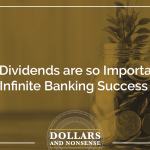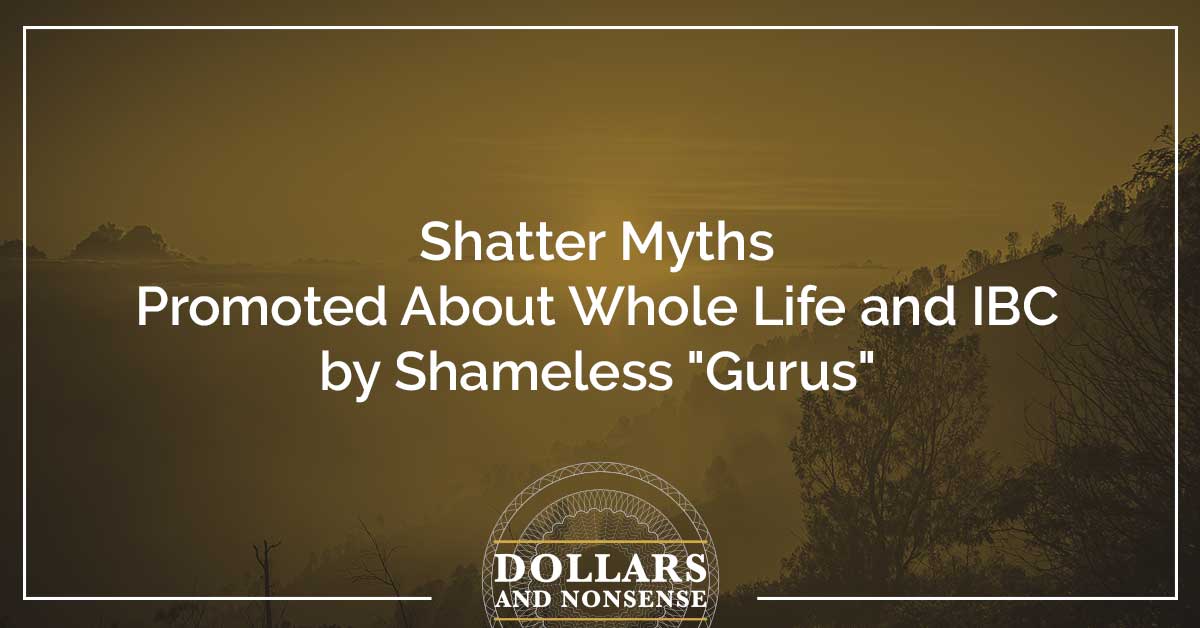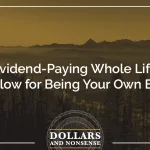In this episode, I discussed the real reasons why universal life insurance policies cannot be used to practice infinite banking. We also cover why participating in whole life insurance must be used to become your banker.
Topics Discussed:
- The detailed flaws of the policies
- What is Nelson Nash’s idea of becoming your own banker
- Why banking is inescapable and a fundamental fact of life
- The impact that last year had on IUL owners and how it came as a shock to a lot of them
- Why you can’t practice IBC with Insurance Universal Life
Episode Resources:
- Gain access to our Beginner’s Course now FREE to listeners of the podcast here now
- What is Infinite Banking
- Who was Nelson Nash?
- CREDIT: Episode art background photo by LinkedIn Sales Solutions
Podcast transcript for episode 168: Solution for IBC Success
Nate: In this episode, I discussed the real reasons why universal life insurance policies cannot be used to practice infinite banking, and also why participating whole life insurance must be used to become your own banker. This is Dollars and Nonsense, if you follow the herd, you will be slaughtered.
All right, everybody, welcome back to the show, it’s great to have you. We are going to dive in today to content that we have spoken about before, the big bad content of life insurance policies, especially universal life insurance policies. For those of you who have been faithful listeners, you know that we’ve talked about this before. This is not our first foray into discussing universal life. And if you’ve been investigating infinite banking, whether you’ve been around for a long time or whether you’re brand new to this concept of infinite banking, I’m sure you have run across videos, podcast, whatever it is, discussing indexed universal life insurance or other forms of universal life insurance. You’ll probably realize that there’s multiple camps out here. You’ll probably realize that some people, I’m included in this, believe that you should not use any form of universal life insurance policies to practice infinite banking. And then, other people will of course say you have to, “It’s way better over here.”
So, I want to dive today kind of describing why I don’t think it can be a fit for IBC, and then I’m going to discuss further than that, more detailed flaws of the policies themselves and why I personally would not recommend doing IBC with them.
So I want to take a step back really quick as we dive into this, and just remind everyone that the idea of becoming your own banker or the Infinite Banking Concept is named a concept for a reason. And so here is the concept. Let’s lay this out. The idea that is set before us, is that in the banking world, if we were to talk about a conventional banking situation that we all find ourselves in, I’ve said this on this show before, I’ll say it again, banking is, banking was here before you were born, it’s going to be here after you die. Banking is inescapable. The idea that money must transfer from one entity to another for the society to operate, this is just a fundamental fact of life that is going to exist in modern societies.
The whole purpose of infinite banking was to look at this and realize, there’s probably more profitable ways to be in the banking world. In the world of banking, this is how the business works. A bank, a conventional bank needs three pieces to it. It needs a depositor to put money into the bank, and needs to have the banking institution itself, and then it needs to have borrowers. There’s essentially these three parties involved in typical banking transactions.
A bank will entice depositors to come deposit money at the bank by offering them interest. The bank then takes the money that depositors leave there and they find borrowers, people who would like to borrow money to achieve things, and they lend money to those people at higher rates. This is the way the banking situation works. So they have deposits getting paid maybe 1% on their deposits, and then they’re going to go find someone to lend to for 5%, a borrower that needs money. And so, the bank is obviously going to keep the profit, the margin between what it’s paying its depositor and what it’s paying its borrower.
So, a banking business is just like any other business. It’s in business to profit its shareholders. That’s what businesses in a capitalistic society do. So in this world, the bank is going to receive profit and it’s going to use that profit to, it’s going to send that profit to its shareholders in some sort of value. And so, small, medium size banks, they may actually have private owners who are receiving that profit in the form of dividend checks. And then the larger banks, they may choose to pay out some dividends, but really, I think everyone’s just wanting their stock to go up in value and that’s how they would rather receive their value. So the bank may do share buybacks or other types of investments inside the business that may produce higher amounts of share price, because that’s how the shareholders in a public company may choose to receive their value.
All that to be said, this is the conventional banking world. What infinite banking does and what Nelson Nash did when he wrote the book, is he took a look at the world of banking as it sat right there and realized a few things. First off, a bank is essentially just a gigantic pool of money that’s been accumulated by depositors who leave money there, and then that money goes out and gets put to work, and a profit is generated, but the depositors seem to be getting very little of it back. The depositors are the one that put the money in, but they’re receiving very little of the money that’s actually being made.
And so, infinite banking looks at this and says, “You know what’s kind of weird here, is that mutual life insurance companies, their business looks hauntingly similar to a conventional bank.” So instead of it being depositors, it’s policyholders, but it’s essentially doing the same thing. There’s a big pool of money that’s created that is then out and is invested in long-term low-risk cash flow producing things, like bonds and treasuries and things of that sort. And just like the bank, the insurance company is receiving a whole bunch of income in interest from the loans it’s making and the bond it’s buying, and so forth, which are just lending instruments. And so, it’s receiving all of this interest back and it is producing a profit. The question at hand though, is who is going to receive the profit that a mutual life insurance company produces on its business model?
And of course, for anyone who’s been around for very long in the infinite making community, you’re aware that in a mutual life insurance company, there are no shareholders of this company. There are no outside owners of a mutual life insurance company. The only owners are the policyholders. And the only way to get ownership in a mutual life insurance company is to buy one specific policy, and that is their dividend paying, participating whole life insurance policies.
Now, the mutual insurance companies may sell other products, but there’s only one that lets you plug in to the banking system as an owner. And so, Nelson Nash presented the idea that you could become your own banker by plugging into a system that already exists, that mutual life insurance companies have been offering for a very long time. And he offered scale to it. He said, “You can do it on a much bigger scale than anyone had really thought you could do it at.” Becoming your own banker is an idea that that requires dividend paying whole life insurance policies with mutual companies to exist in order for the concept to exist.
On the flip side, we’re now going to transition to the universal life insurance world. And in this world, the most common type of universal life insurance policy is indexed universal lifer, IUL. It’s a new kid on the block. It’s the newest form of life insurance that exists on the marketplace today. Universal life itself is relatively new. Whole life is very, very old. Universal life was invented in the ’80s, just to begin with. And so here we are, we find ourselves in this world where IUL, the index universal life policy is becoming more and more and more popular. And we have always pushed forth the idea that you really can’t become your own banker with IUL because it is not a concept based system anymore. IBC is what it is because it is a concept that uses dividend paying whole life insurance issued by mutual companies to become your own banker, and it is unique in its ability to offer that.
So, IUL comes along and it says, “We can essentially generate a better system in the world of IUL for individuals.” But remember, whenever you buy an IUL policy from the insurance company, you are not an owner of the insurance company, you are just a customer. You are a customer in which the insurance company would like to be making money off of you. The first thing you must know about any sort of universal life policies, is that they are created in such a way to guarantee that the insurance company will not lose money on these policies. Because they’re not in ownership, there’s no partnership agreement here. In other words, the insurance companies have essentially created a pricing mechanism in universal life that gives them total control over how much fees and how much money you’ll actually earn in it into the future of which you have no control over. And in which case, you’re just kind of hoping that things are going to work out, though you guys are not in this together per se.
In other words, there could be a conflict of interest occurring inside of a universal life policy that can’t really exist inside of a mutual company. In a mutual company, there’s no conflict of interest. What’s good for the insurance company, which makes it more profitable, is good for the policyholders. So, in the universal life policy, just to again give you some background, what is an IUL, what is universal life? It’s a permanent policy where you’re paying premiums and those premiums are diverted, one into an interest-bearing like savings style account, and the other’s going to pay for the cost of insurance and the fees of the policy. It’s essentially built on what’s called an annually renewable term chassis, where there’s a cost of insurance, the cost of the death benefit of the policy is going to keep climbing the older you get, the more expensive the death benefit becomes, and then whatever’s left over after the cost is paid of what you paid in premium, goes into this investment style account.
And so, with an IUL policy, it’s an indexed universal life policy and it’s supposed to be tracking an index. And the features that they’re trying to sell you on is that, in an IUL policy, when a market tanks, let’s say the S&P 500 tanks, the interest-bearing account that you have inside of this universal life conglomerate never can lose money based on a market tanking. On the flip side, you can achieve higher gains, typically with some sort of cap rate or some sort of participation ratio. Which all just mean, that the insurance company is saying, “Yeah, if the market does really, really well, then the policy can grow pretty high and if the market tanks, it’s not going to be very bad for you.” That’s the pitch and people line up for this thing.
See, this sounds great. But the problem is, that underneath the floorboards there’s some things festering. And this is why we’re saying that the policies are essentially priced to where the insurance company can make sure that they’re always making a profit on these policies, that they’re always profitable. If you are a dividend paying whole life insurance policyholder and your mutual company is selling universal life policies, sometimes this can be a good thing. Because hopefully, it’s going to produce more profits for all of us. Which by the way, we’ve talked about before. These mutual insurance companies sell term insurance, disability insurance, universal life insurance, annuities, all sorts of things, where these things produce profit to the company, where do all those profits get to go?> They go back to the dividend paying whole life policy owners, because we are the only shareholders in the company.
So we go back to the universal life idea in this circle, and it’s price in a way where the insurance company reserves the right to change almost everything in the policy. So we’ve already talked about how the cost and the fees are not set. There may be a contractual maximum that you can see in a universal life policy, but either way, the illustration that you’ll get with your policy is just going to show whatever the current scale is, and if things ever, if they ever need to, you can see them increase the cost and fees up to a contractual limit that’s based on the contract, they can increase the cost of it whenever they choose to, which kind of defeats the purpose.
And then on the flip side, they also have contractual rights to change the crediting max that they will offer for their policies. So let’s say the market does 20%, but they may have a cap rate. And they kind of price differently, you can have a few different things as far as what your policy will return. But let’s just say your cap rate was 10%, which means that if the market did 20%, your policy would only grow by 10%. But that’s actually just a current cap rate, they have the right to change it anytime they want. So they could just easily lower it down to 8% for the next year if they needed to lower the cap rate to make this engine more profitable. And so, what you have is the risk is being transferred back to the policyholder.
In other words, the insurance company is saying, “Hey, you might, if the market does really, really well and we choose not to lower the cap rate and we choose not to increase expenses, this policy could look pretty good. But if anything gets in the way here, whether the market does poorly, so your crediting rates aren’t very good, or we need a little extra capital, we need these things to become more profitable, so we’re going to up the cost or lower the cap rate or whatever it is, we get to decide that on our own and you have no say in the matter.” This is of course why we would be concerned, and it just points to the fact that it is not a part of the Infinite Banking Concept for this to occur. That’s essentially what we’re trying to say.
So obviously, the concept rules out IUL, because it doesn’t fit the features that are necessary to become your own banker and own the bank, because you’re just a customer now. And as you are just a customer, the bank is not in business to make you money, and it has reserved the right to change, pretty much everything in these policies into the future, you get no say in it. And this is obviously the main reasons why we’re very concerned about it.
One of the reasons I wanted to bring this up, was I write an article from the Wall Street Journal, I’ve got it in front of me as well, it was written back in December of 2022. And it essentially was describing the impact that last year had on IUL owners and how it came as a shock to a lot of them, and how a lot of advisors are concerned about the policies that they’ve written because all this was kind of hidden under the floorboards. It’s exactly what we’ve said all along.
Let me read this and then let me tell you what exactly it means. Essentially it was describing how IUL had been just taking off for the last decade, but it’s now, the sales are starting to dwindle down because of the market conditions. It said that the millions of Americans who now own these policies saw the ideal conditions for IUL reversed in 2022, exposing the policies, high fees and complexity. And so it goes on to say that, policyholders of IUL policies did avoid the stock market losses this year, but the declines expose them to high fees and charges, which are still deducted from their accounts.
And this is exactly, by the way, what we’ve been trying to say for so long. That just because the account itself, inside of a universal life policy, like an IUL policy, just because it can’t lose value due to market losses does not mean you can’t lose money doing IUL or whatever else it is. Because in a marketplace like last year, where there was a decline in the stock market, that means there was 0% credited to that account, but all of the costs and the fees of those policies still have to be paid. The account value may not have decreased because of the loss, but you did lose money this year.
One of the guys says, “If I knew what I know now, I wouldn’t go for the IUL.” And he described what happened to him, which I’m going to read too, and one of his new advisors describes that, “Consumers are pitched market-like returns without the risk. It appears to them to be a win-win-win option when it isn’t, because of the fees cutting into the return.” She calculated that for one of this guy’s IUL policies, his expenses tallied $6,000 of the $14,000 premium that he paid. So in this year of 2022, he paid a $14,000 premium throughout the year, 6,000 of it went to just pure cost. So he lost $6,000, and get this, it was in year nine of the policy. He had a nine year-old policy that just lost $6,000.
And so, this is why if you look at universal life policy illustrations, they always just assume a straight average rate of return occurring throughout the whole time, but that’s not how life works. So this is why we find an issue, that when people come to retirement, they can see all these rosy illustrations building up for retirement on an IUL policy that they bought, that the issue becomes, if the returns in the account aren’t strong enough to overcome the rising cost and fees that are guaranteed inside of an annually renewable term chassis that exists inside of IUL, so the cost of the death benefit gets more and more every single year, if the returns don’t pan out as well as they had hoped, it is very possible that the cost of the policy itself, the fees inside of it, are outpacing the growth inside of the policy, the interest being earned inside the policy. It’s possible.
Now, some people will say, an IUL Homer may say that it’s not probable, but man, that’s the kind of a concern. There’s another thing to note, there is no such thing as guaranteed cash value inside of an IUL. If you looked at an IUL illustration and you looked at the guaranteed side of the ledger, every single time IUL always implodes on the guaranteed side. Which essentially just means, there are no guarantees. The guarantee is that you’ll lose all of your money at some point, that’s the guarantee. Now of course, that’s not probable. I’m just merely saying that’s what it’s going to show every single time, an IUL policy is going to show all the money going to zero at some point when the cost of insurance gets too high and overwhelms the growth of the account.
Now the guarantees are improbable in that scenario, I understand that. I’m just merely saying, that’s what you get with an IUL style policy. It’s just interesting to see the Wall Street Journal write an article describing exactly what we’ve been trying to say, which is, everything is not rosy over here in the universal life world. The cost of the policy is not set. The returns are completely based on market instruments, first off, like the S&P 500, and the insurance company not reducing the cap rates or the participation ratios that they allow anyway. They have the contractual right to do both of those things, raise costs, lower cap rates. And on top of that, you’re not an owner of the insurance company. So the insurance company is treating you like a customer, it’s selling you this policy in such a way that it knows it’s going to make a profit because it maintains control of the levers and any profit it does make just goes back to the dividend paying, participating whole life policy owners anyway.
All of this is to say, the reason why I said this is definitive, is because an IUL may make sense for someone who wants to have some sort of market exposure but is terrified to lose money. That’s who it’s supposed to be pitched to. But is of course, you even start getting into more wonky scenarios when you actually want to practice IBC with it.
If we take this guy himself right now, he’s got a policy that’s nine years-old. He paid 14,000 of premium, 6,000 of it on a nine year-old policy went purely just to pay for the expenses in the policy, so he is already lost $6,000. Let’s just assume he’d been putting in $14,000 for nine years. Well, that’s going to probably put him close to $140,000 of cash value easily at that point in time. And let’s say he had been practicing IBC with it, and he went out and took out $140,000 policy loan against his IUL policy to do IBC. Well, he’s still got to pay policy loan interest on the policy loan. So this year he would’ve lost $6,000 from the market dropping and having to pay for the cost and fees, and he would’ve had $140,000 loan, let’s say the loan rate at the IUL may have been 5% or whatever, there’s a whole bunch of different options there, it gets very confusing. But at 5%, that would be 7,000 bucks that he would’ve owed on $140,000 loan. So essentially, he would’ve lost $13,000 in year nine of his system on $140,000 balance by practicing IBC with the system.
We’re saying that this type of scenario, we would like to avoid. We don’t think it’s the ideal situation to practice IBC. The costs are not guaranteed. The cap rates are not guaranteed. The market is certainly not guaranteed. The borrowing ability of the policy can result in some wonky situations happening whenever you don’t earn any money in a year. And then to top it all off, if the whole goal for this person was to retire one day with this policy, that starts to get extreme. Because then you could have had a situation 10 years further down when he has $500,000 and a bigger scale or so inside of the policy, where the cost of insurance is now higher, he’s having to take money out of the account to live on, and you have to do it through policy loans, and so you’re taking money out in policy loans to live on and having to pay interest. You can lose a lot of money really quickly if things don’t work out perfectly.
I personally look at all of this and I say, “It’s probably not worth my time, probably not worth my time.” But I do know that it’s out there, and if this does nothing else, but then just give you some ammunition to be confident in your choice, I think that’s great if you’re looking into the two. Once again, IUL may be great. If everything works out great, I’m sure it’s going to work great. But that’s the case with every financial strategy. If everything works out great, it’s going to be great. But it very well might not be able to. This is why I don’t understand why you would take something that we know is going to work and instead choose, “Well, maybe IUL could produce some sort of additional value.” Maybe it could. If the market does great, if the cost are never increased and the cap rates are never changed, I’m sure it could work out just fine.
But it very well could not either, and you very well could end up losing money in the time where you really can’t. This is why there’s so many horror stories for universal life policies that have been underfunded, that were issued in the 1980s, 1990s that are imploding and people are losing all the money they put into them. There’s news articles all the time about it, because of the way they’re structured, it can be very confusing and dangerous at times.
So I hope this has been helpful everybody. I would say, remind yourself when going into IBC, that it is the concept that we’re after. That dividend paying whole life insurance policies are used because they allow you to plug into a banking institution as an owner. This is the entire concept, that’s why they’re used. There are other tools out there that can offer similar features of capital accumulation and ability to borrow. And those things that will work fine, I guess, it’s just not the Infinite Banking Concept. You are just back into kind of a customer mentality, you’re giving control back to somebody else. Instead of the institution working synergistically with you, there’s often some sort of conflict of interest between you as a customer and the company itself that’s offering it, and the owners of that company, of course, are not going to allow their company to sell policies that make them lose money. So that they must be structured in a way that makes sure the company will always profit, which puts you in a bit of a conflict of interest. So they’re trying to make money off of you, again, which is what we’re trying to avoid.
So I hope this has been helpful. There are probably more problems we could go into, but it really all stems from those. It really does. It stems from the fact that we’ve given up control of our future back to the insurances company, and on top of that, there’s a conflict of interest that we’ve created now, because the insurance company really doesn’t care as much about you, you are a customer, they’re here to make money off you. They control the levers to make sure that they do make a profit off of you. And then it just happens to be, that if you’re working with a mutual company, the profit that is generated just goes back to the dividend paying, participating policyholders, like you and me who are practicing IBC. Just like it is with the term insurance policies and annuities and disability insurance that they sell as well. If you have any questions about or thoughts, feel free to email me anytime. You can reach me at nate@livingwealth.com. It’s been great, again, this is Dollars and Nonsense. If you follow the herd, you will be slaughtered.
Announcer: One last thing before you go, start your journey towards financial security and wealth today, visit livingwealth.com/beatinflation. You’ll gain instant free access to the beginner’s course of Ray, Nate and Holly made just for you. Again, that’s livingwealth.com/beatinflation.









